 |
|
|
News
About Us
Membership
Events
Links
|
|
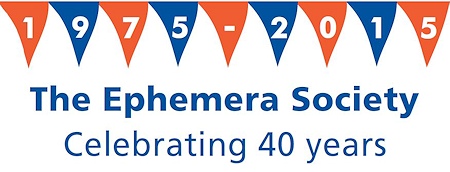
Sally de Beaumont relates a detailed history of the British Ephemera Society from its founding up to 2010. This article was originally published, in French, by the French ephemera society Le Vieux Papier in their journal "Le Vieux Papier" issue number 396, April 2010. Passion for the printed and handwritten artifacts of social, cultural and visual history is the backbone of both our societies. It unites us in spirit, if not in title. Founded some seventy-five years apart (Le Vieux Papier in 1900, The Ephemera Society in 1975) we both acknowledge, in the words of Maurice Rickards, founder of the British Society, the importance of "the minor transient documents of every day life". The word ephemera (taken from the Greek: epi (on, about) and hemera (day), is now the common term for such documents in Anglo-Saxon countries and those countries closely affiliated with us, such as Australia, Brazil and Sweden. The word also evokes the mayfly, an insect whose short life not only shines brightly but attracts those hungry to feed. The fleeting glory of such material and the role it plays in the everyday workings of life will make our word immediately familiar to any French angler. Early in 1975 a group of seven enthusiastic collectors, one American and six British, were invited to the home of Maurice Rickards to discuss the possibility of creating a society of like-minded individuals who as he then put it would "love ephemera for its own sake, but also recognise its value as historical evidence". To quote Graham Hudson writing in our journal The Ephemerist in 2000, "Hand picked from his numerous circle, he must have chosen us like Yul Brynner choosing his Magnificent Seven: Peter Jackson of the London Topographical Society, the London collector; Patrick Robertson, specialist in magazines and pictorial newspapers; Amoret Scott (now Tanner), funeralia, Duke of Wellington, and parrot ephemera; John Hall, lettering, typography, and chromolithography; Calvin Otto of Vermont, specialist in paper Americana illustrative of social history; John Lewis, doyen of ephemerists, author of the seminal work that had given respectability to my own interest, Printed Ephemera - the changing face of type and letterforms in English and American printing; and me (a bit of this and a bit of that)." With Maurice as Chairman and general overseer all began the task of mounting an exhibition of items culled from their private collections. Entitled This is Ephemera, it opened to the public on I remember my first visit vividly. Having seen a colour centre-spread in one of the Sunday magazines promoting the exhibition, I rushed to Paper Point early in the morning, knowing I had a plane to catch later that afternoon.
I was bowled over by the display, for not only was it stunning, it opened up worlds of which I knew nothing. Muttering to myself "Wow! Wow! Wow!" as I discovered yet another treasure, I soon realised that I was being followed around the gallery. It was Maurice himself and he knew he had found another enthusiast. Of course I joined on the spot, member number 11 as it happens, but I avowed to Maurice that I was not really a society type of person. Little did I realize that some 26 years later I would become its fourth Chairman, a position now held by Valerie Jackson-Harris, widow of the late Peter Jackson, who preceded me as Chairman and who had carried on after Patrick Hickman-Robertson had taken over the reins from Maurice. A modest four page newsletter, The Ephemerist, was produced by Maurice to coincide with the inaugural exhibition. In it he promised "as the Society grows, so will the journal". More on this later, as there is still much history to be told. With ephemerists appearing out of closets everywhere, well not everywhere, but at least enough to let the numbers reach 200 or so by the late 1970s, activities blossomed. The Society began a series of monthly lectures in London given by new members willing to share their knowledge. We had days out to such places as Lilies (a bibliophile's paradise) and Stratfield Saye (home of the Dukes of Wellington).
But back to the past. The success of the Society's first exhibition engendered a long running annual series of similar displays in London with titles such as All The Year Round (featuring Christmas cards, 'printed on the ice' tickets and poisson d'avril postcards), 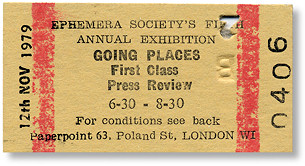
Clipped ticket, a memento, of Going Places exhibition, November 1979. These exhibitions continued for many years and some of them toured the country and beyond. Perhaps the most important tour of all was that of This Is Ephemera which was displayed in Bennington, Vermont and opened the doors for the now well established Ephemera Society of America, founded in 1980, a sister society with whom we enjoy very close ties. Growth continued and soon we counted many major English and foreign institutions as fellows. This opened the way for another benefit of membership: behind-the-scenes visits. Those we have enjoyed the privilege of exploring are too numerous to list, but some that spring instantly to mind are the John Johnson Collection at the Bodleian Library, the Victoria & Albert Museum, the British Library, St Bride Library, The Magic Circle and the Centre for Ephemera Studies at Reading. Many members live a considerable distance from London, and here I include those from Scotland and Cornwall as well as those from Ghana, Hong Kong and New Zealand (we have 700 plus members in over 20 countries).
Another council member, Malcolm Warrington, came forward in 2002 with the offer of creating a website. This has been an exceptional success. With visits from all around the globe (except for the Arctic and the Antarctic) many new members have joined through and because of it. Clearly laid out and providing information about joining the Ephemera Society, it lists such relevant events as exhibitions and paper fairs (including the Salon du livres et papiers anciens), and includes news of current happenings and previous articles from The Ephemerist. There is an "item of the month" and a page for queries. One of its strongest assets is the "links" section which is added to regularly and is an astonishing source of information for those interested in ephemera. Beside the visits, lectures and fairs already mentioned, we also meet for our AGM, a yearly Christmas party in December and on the occasional presentation of the "Pepys Medal". This is the award we bestow "for outstanding contributions to ephemera studies". Fourteen recipients, most of them authors of seminal works on ephemera, carry this honour. As the Society grew so did the realisation of its academic aspirations. The Foundation for Ephemera Studies was established in 1984 with the long-term aims of setting up a permanent archive and initiating research projects. As a registered educational charity, it was a separate body from the Society, albeit a very closely connected one. An early project, funded by a grant from the Leverhulme Foundation, was research into the artifacts produced by compound-plate printing and a reconstruction of the press capable of such ephemera. Perhaps the most significant advance was the inauguration in May 1993 of The Centre for Ephemera Studies - the first of its kind in the world - housed in and administered by the Department of Typography & Graphic Communication of the University of Reading. Professor Michael Twyman serves as Director of The Centre and is helped by a staff of volunteers. The Centre's first Patron is Lord Briggs, the distinguished social and cultural historian. Asa has long been a committed ephemerist and is also the honorary President of the Ephemera Society as was the late Sir John Betjeman before him. At the heart of the Centre is the collection of ephemera built up by Maurice Rickards (the Rickards Collection) which he donated to The Foundation and which is on permanent loan from them to the University. The Centre buzzes with activity. It runs courses on various aspects of ephemera and has produced some invaluable research tools, including a register of public collections in the United Kingdom. Currently work is progressing on a thesaurus of terms connected with ephemera. One achievement of which we all are proud was the completion and editing (a task primarily undertaken by Michael Twyman, with help from Amoret Tanner and myself) of Maurice Rickards' The Encyclopedia of Ephemera (London: The British Library; New York: Routledge, 2000). The publication won The Library Association's Besterman/McColvin Medal for "an outstanding work of reference" that same year. As is apparent, The Society, The Foundation and The Centre play different roles but remain inextricably linked. It has been my pleasure to tell vieux papierists about each of them. Copyright © Sally de Beaumont 2010. All Rights Reserved.
|
|
|
Home | News | About Us | Membership | Events | Links | Contact | Item of the month | Articles |
| Copyright © The Ephemera Society 2025. All Rights Reserved. |
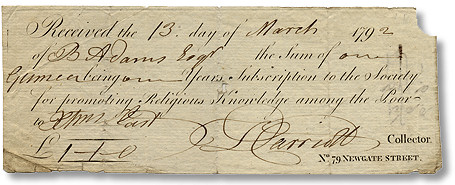
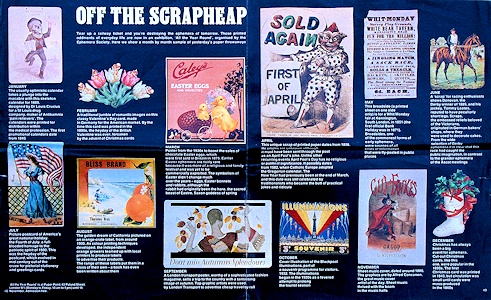
 But it was the first 'bazaar', a trading fair held in December 1976 in a freezing cold church hall in London, that really set our membership alight. Fully booked by members wishing to sell on unwanted pieces and attended by even more avid collectors, the day was an unmitigated success. And so began our series of fairs and bazaars that continue to this day. Now six a year and for the moment held at the Holiday Inn, Coram Street, London WC1N 1HT, these exciting events continue to rekindle friendships and add the bi-monthly excitement of discovering the yet unknown or the missing links in a collection.
But it was the first 'bazaar', a trading fair held in December 1976 in a freezing cold church hall in London, that really set our membership alight. Fully booked by members wishing to sell on unwanted pieces and attended by even more avid collectors, the day was an unmitigated success. And so began our series of fairs and bazaars that continue to this day. Now six a year and for the moment held at the Holiday Inn, Coram Street, London WC1N 1HT, these exciting events continue to rekindle friendships and add the bi-monthly excitement of discovering the yet unknown or the missing links in a collection. 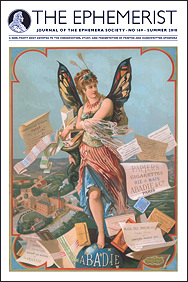 Their life-line to the Society is
Their life-line to the Society is 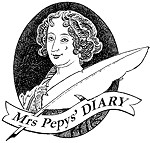 We have a page of "Notes & Queries" (members contacting others to discover the where, why and when of recent discoveries) and "Mrs Pepys' Diary" (our gossip column which fills in all the blanks likely to be missed). Although I cannot reveal the current name of Mrs Pepys, I can remind you that Samuel Pepys (1633-1703) collected ephemera when he was not working in the Admiralty or writing his diaries. His collection is now housed at Cambridge.
We have a page of "Notes & Queries" (members contacting others to discover the where, why and when of recent discoveries) and "Mrs Pepys' Diary" (our gossip column which fills in all the blanks likely to be missed). Although I cannot reveal the current name of Mrs Pepys, I can remind you that Samuel Pepys (1633-1703) collected ephemera when he was not working in the Admiralty or writing his diaries. His collection is now housed at Cambridge.